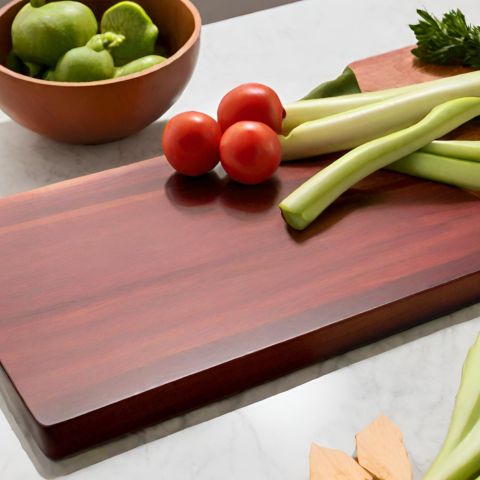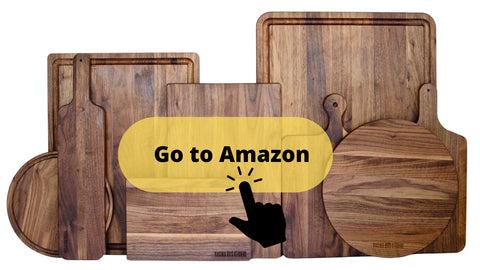Mahogany, renowned for its strength, density, and durability, has long been a sought-after material for various applications. From furniture to musical instruments, its reddish-brown hue and tight grain often make it a top choice. But how does it fare when it comes to cutting boards? The answer lies in a combination of functional and aesthetic factors.
While mahogany's natural resistance to water and warping makes it seem like an excellent choice for kitchen environments, there are several factors to consider. This analysis will delve into the practicality and aesthetic appeal of mahogany as a material for cutting boards. We will also explore its alternatives and answer some of the most frequently asked questions about these kitchen essentials.
Related article: if you're interested in about all the different types of wood, check out our other article on the the best wood for cutting boards.
What is Mahogany?
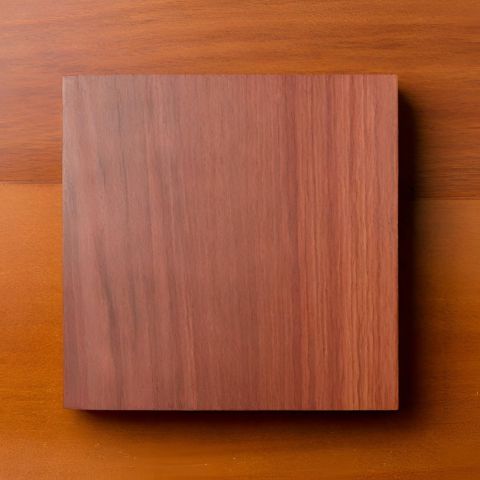
Originating from tropical trees, mahogany is a type of hardwood characterized by its strength and durability. Its appealing reddish-brown hue and tight grain contribute to its elegant appearance and smooth, less porous surface.
These characteristics have made mahogany a popular choice for various applications, including furniture and musical instruments.
When it comes to cutting boards, mahogany's natural resistance to water and warping makes it a viable contender. However, like all materials, it has its pros and cons.
Its functionality and aesthetic appeal can make a mahogany cutting board a long-lasting addition to your kitchen, but there are also significant factors to consider, such as sustainability and porosity.
Reasons Why Mahogany Wood Is Not the Best for Cutting Boards
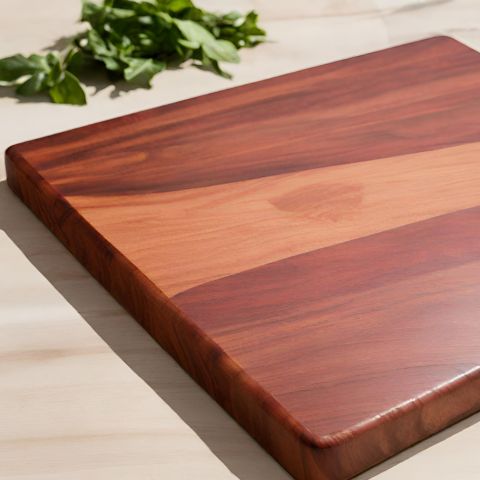
Deciding on the best wood for cutting boards is a complex process that considers several factors, such as toxicity, hardness rating, porosity of wood grain, sustainability, and conditioning and maintenance.
Here are some reasons why mahogany isn’t the best wood to curve out a cutting board:
-
Sustainability
When it comes to sustainability, mahogany fails to meet the mark. Mahogany trees can take up to 30 years to grow, making it unsustainable to use them for cutting boards. In contrast, faster-growing trees like walnuts, harvested in the United States, are a more eco-friendly option for crafting cutting boards.
This is a reason why Virginia Boys Kitchens uses walnut wood in our cutting boards - sustainably grown, sustainably harvested.
-
Porosity of the Wood Grain
The porosity of wood plays a significant role in determining its suitability for cutting boards. Mahogany, being an open-grained wood, can trap food particles and harbor bacteria, making it less than ideal for regular kitchen use.
Other factors, such as how trees grow and the type of wood grains they possess, also influence their suitability.
For instance, end-grain cutting boards are less prone to absorbing liquids containing bacteria and mold, making them a safer material for your cutting board than mahogany.
-
Weight
One of the key characteristics of mahogany is its weight. This heavy hardwood can make maintaining and maneuvering a cutting board challenging. The sheer density of mahogany makes it cumbersome, especially in larger sizes, which might be a hindering factor for some users.
-
Hardness Rating
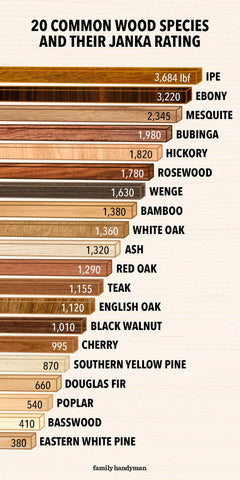
When considering the hardness of mahogany, it's important to refer to the Janka hardness scale.
This tool measures the resistance of wood to wear and denting. Mahogany, despite being classified as a hardwood, has a relatively lower Janka hardness rating, sometimes as low as 800.
For cutting boards, a rating of around 1000 is typically recommended. This level of hardness strikes a balance between durability and knife-friendliness, ensuring your board lasts while keeping your knives sharp. Walnut wood meets this criteria perfectly.
Related: See our collection of Walnut Wood cutting boards
-
Cost
Another factor to consider when evaluating mahogany for cutting boards is cost. Mahogany is a high-end wood, often associated with luxury furniture and fittings. As such, it tends to be pricier than other woods. Its high cost might make it less attractive for a utilitarian item such as a cutting board, especially when there are more affordable alternatives available.
Perfect Alternatives for Making Cutting Boards
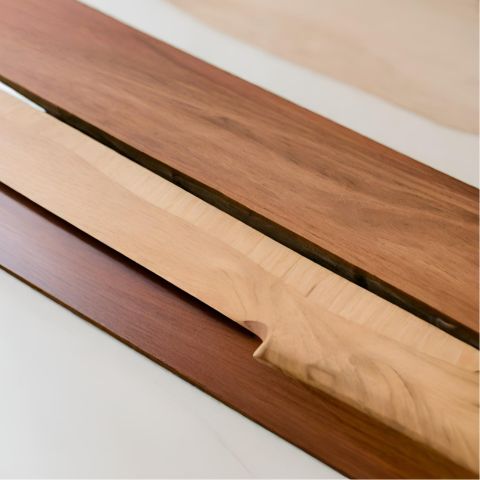
While mahogany may not be the ideal choice for cutting boards, there are plenty of other options. Here are some perfect alternatives:
-
Walnut
Walnut stands out as a premium material for cutting boards. It is slightly softer than mahogany, making it easier on your knives while still providing enough durability for regular use.
This unique aesthetic of walnut offers a rich, dark color that adds an elegant touch to any kitchen.
Furthermore, walnut cutting boards are a great investment for any home cook or professional chef. They offer a combination of functionality and style that is hard to beat. For a closer look at walnut cutting boards, visit our walnut cutting boards page.
-
Maple
Maple is a popular choice for cutting boards due to its durability, tight grain, and appealing aesthetics. This type of wood stands out for its reddish color that adds a touch of warmth and elegance to any kitchen.
Moreover, maple's density helps in resisting knife marks, ensuring that your cutting board will last for years with proper maintenance.
Between maple and walnut, it comes to your preference of a blonde color or a dark wood color.
-
Teak
Teak, on the other hand, is famed for its high oil content, which gives it an innate resistance against moisture and mold. This characteristic, combined with its moderate hardness, makes it an excellent choice for cutting boards as it doesn't dull knives quickly.
However, let's talk about why it's not the best choice:
Despite being a bit more expensive than other wood types, teak's longevity and low maintenance make it a worthwhile investment for many homeowners.
Moreover, teak is frequently imported from overseas - where manufacturing, harvesting and growing criteria is different than the United States. They are chemically treated before being allowed to be imported into the states.
This is hardly what you want on your cutting board where you prepare raw meat!
Click here to see a more in-depth article on which wood is best for cutting boards.
Frequently Asked Questions
-
Which wood variety is the most suitable for crafting a cutting board?
While many hardwoods like mahogany, maple, and cherry are excellent choices for cutting boards due to their hardness and durability, walnut stands out as the most suitable. This is because walnut offers a perfect balance between hardness, grain density, and resistance to wear and tear. Its tight grain helps resist bacteria and food particles, ensuring food safety. Furthermore, the wood's innate hardness prevents deep knife marks, while its juice groove design aids in catching food and liquid runoff.
-
What woods are toxic for cutting boards?
When it comes to food preparation, safety is paramount. Certain kinds of wood, particularly some exotic woods, are not suitable for cutting boards. These woods include western red cedar, rosewood, American Mahogany, pine and birch.
-
Why do chefs prefer wooden cutting boards?
Chefs often favor wooden cutting boards for several reasons. Firstly, wooden boards are kinder to knives, reducing the risk of ending up with a dull knife after prolonged use. They are also known for their durability, providing a stable and sturdy surface for a wide range of cutting tasks. The regular maintenance required for wooden boards, such as oiling, also helps to keep them in good condition and extend their lifespan.
Wrapping Up
In the end, the question of whether mahogany is good for cutting boards depends on multiple factors. Mahogany certainly has a unique appearance that adds a touch of elegance to any kitchen. However, the grain of the wood is quite porous, and the hardness rating is not as high as other types of wood, such as walnut or maple. This means that while mahogany cutting boards may look beautiful, they may not stand up to heavy use as well as other options.
Related Articles
Best Cutting Boards for Brisket
RELATED PRODUCTS YOU MIGHT LIKE
See Virginia Boys Kitchens On Amazon
We are on Amazon, see our storefront here. Use coupon code VBKBLOG10 for 10% off your entire purchase of any Virginia Boys Kitchens on Amazon. Apply the code at checkout.

